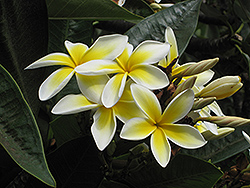Common Frangipani
Plumeria rubra var. acutifolia
Height: 4 feet
Spread: 4 feet
Sunlight:
![]()
![]()
Other Names: Nosegay, Temple Tree, Mexican Plumeria
Description:
A popular shrub or small tree, producing showy white flower clusters over deep green contrasting foliage ; often used as an indoor accent plant; pruning required to maintain strong structure; parts of this plant are known to be toxic
Features & Attributes
Common Frangipani features showy clusters of fragrant white trumpet-shaped flowers with yellow throats at the ends of the branches from mid summer to mid fall. Its pointy leaves remain dark green in color with curious light green undersides throughout the year.
This is a multi-stemmed houseplant with an upright spreading habit of growth. Its relatively coarse texture stands it apart from other indoor plants with finer foliage. This plant may benefit from an occasional pruning to look its best.
Planting & Growing
When grown indoors, Common Frangipani can be expected to grow to be about 4 feet tall at maturity, with a spread of 4 feet. It grows at a medium rate, and under ideal conditions can be expected to live for approximately 30 years. This houseplant will do well in a location that gets either direct or indirect sunlight, although it will usually require a more brightly-lit environment than what artificial indoor lighting alone can provide. It is very adaptable to both dry and moist soil, and should do just fine under average home conditions. The surface of the soil shouldn't be allowed to dry out completely, and so you should expect to water this plant once and possibly even twice each week. Be aware that your particular watering schedule may vary depending on its location in the room, the pot size, plant size and other conditions; if in doubt, ask one of our experts in the store for advice. It is not particular as to soil pH, but grows best in sandy soil. Contact the store for specific recommendations on pre-mixed potting soil for this plant. Be warned that parts of this plant are known to be toxic to humans and animals, so special care should be exercised if growing it around children and pets.
There are many factors that will affect the ultimate height, spread and overall performance of a plant when grown indoors; among them, the size of the pot it's growing in, the amount of light it receives, watering frequency, the pruning regimen and repotting schedule. Use the information described here as a guideline only; individual performance can and will vary. Please contact the store to speak with one of our experts if you are interested in further details concerning recommendations on pot size, watering, pruning, repotting, etc.
-- THIS IS A HOUSEPLANT AND IS NOT MEANT TO SURVIVE THE WINTER OUTDOORS IN OUR CLIMATE --

